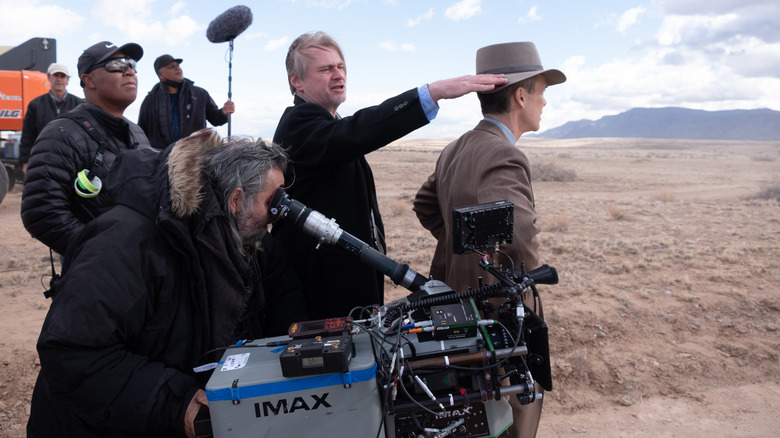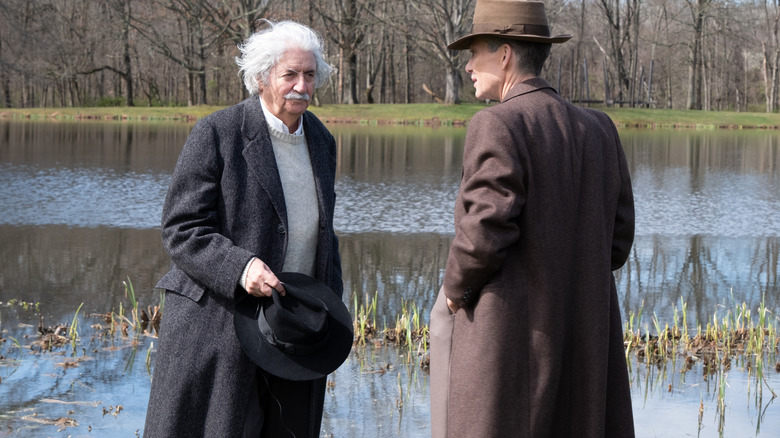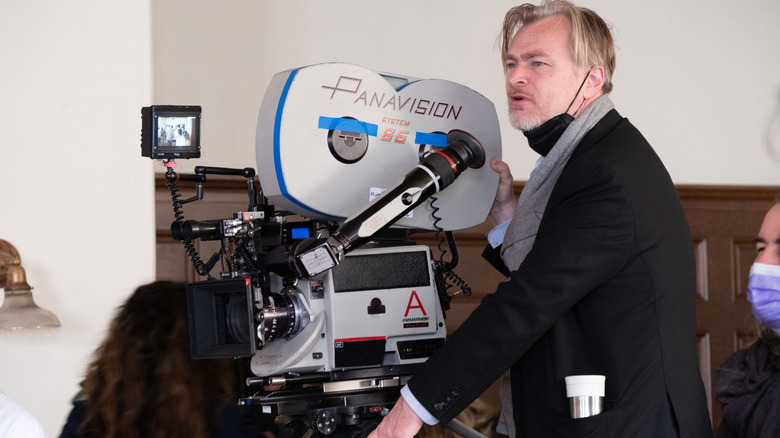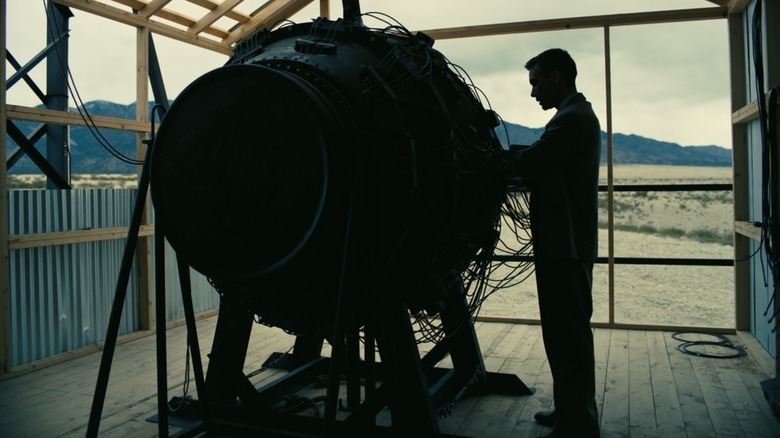Oppenheimer Cinematographer On Filming Quantum Physics And Blowing Up A Bomb [Exclusive Interview]
If he's not a brand name just yet, he's well on his way to becoming one. Hoyte van Hoytema has catapulted himself into the stratosphere of the most talented and prolific cinematographers currently working, starting in 2008 with "Let the Right One In" (directed by Tomas Alfredson, with whom van Hoytema would eventually reunite for "Tinker Tailor Soldier Spy"). Soon, he found himself working alongside the likes of Spike Jonze, Sam Mendes, Jordan Peele, and, of course, Christopher Nolan. Their partnership began with 2014's "Interstellar" and has now culminated with "Oppenheimer" — perhaps the most daunting of all their prior collaborations. And that's really saying something, too.
"Oppenheimer" not only charts the immensely complex life of J. Robert Oppenheimer, portrayed by the brilliant Cillian Murphy, but it also includes several other added-value elements: Crisscrossing timelines with one segment taking place in black-and-white, a series of haunting visuals of quantum physics that plague Oppenheimer throughout the film, and, yes, the show-stopping sequence involving the first-ever test detonation of a nuclear explosive. That's been hailed as Nolan's finest directorial hour, and it couldn't have been pulled off without van Hoytema's invaluable contributions behind the camera. During a recent Zoom interview, I was able to talk to him about what keeps bringing him back to work with Nolan, his approach to working in various genres, and figuring out how to build a sense of dread into the recreation of blowing up that bomb.
Note: This interview has been lightly edited for clarity and brevity.
'It's more about feeling than about theory or concepts'
You've been behind the camera for Chris Nolan's last four movies now. How has your dynamic with him changed over time?
Through the years, you get a better shorthand. I think our relationship always has been quite intuitive from the beginning. It's more about feeling than about theory or concepts, but we know each other's tastes very well after these 10 years and we have so many of the same references and we have watched so many of the same films and have had the opportunity to live with it and talk about it. So I just feel that we have a very intuitive, no-nonsense, no-bulls*** shorthand. A lot of things we don't necessarily have to discuss anymore. And a lot of things you just know of each other and so you can be very direct and you can easily cut through the white noise.
With "Oppenheimer" specifically, what were your earliest conversations like with Chris? Did he have the visual aesthetics of the movie already in mind, or was it more of a back-and-forth with you to refine it over time and figure it out together?
Like I said with that shorthand, right? That's basically, I'm getting a phone call and Chris says, "Can you come over and read the script?" And then I come over and I read the script and then he says, "What do you think?" [laughs] Chris has already very extensively thought about this film. His films are so complex and they're so well put-together that the moment that Chris presents this work to the outside world initially, when it's still on the page, I think he has been pondering over it for a long time. He has been working on it very intensely. And I think he takes a lot of power out of having a lot of things inside his own head worked out before he starts to approach and talk. When you read the script, automatically you're humbled because you very much can read it off-base and you also realize that.
So initial conversations are always much more inquisitive. I'm curious to what he's thinking. There's some things that are not obvious from the script. Some things there are very obvious from the script. I see that initial process much more about, I just want to pick his brain. I want to just figure out what's in his head before I open my own big mouth [laughs] and start to tell him how I think this should be shot.
On the other hand, his scripts are very dense and they're not full of cues of how things should be shot or how things should be done. It can literally be an eighth of a page and you read it and you realize, "Hmm, this is going to be a couple of days of shooting." So there's a lot of things that still need to be worked out. But as you start prepping, some things he has figured out and some he hasn't totally figured out and he needs to see places, he needs to hear some ideas as well. But I would say the initial conversations are careful, inquisitive, full of respect, but open and relaxed.
'I love doing different genres just because it keeps your film language a little fresh'
One thing I find fascinating about your career so far is it seems like you have no problem going from one genre to the next. And especially with Nolan's films: "Interstellar" is sci-fi, "Tenet" is an action/thriller, and now "Oppenheimer" is more of a historical drama. Does working in different genres change how you approach each film?
In the end, when you're doing a genre film, you're not necessarily approaching it as a genre. You ultimately want to invent your language to a film, right? You want to tell the story the way you feel the story needs to be told. To limit yourself with the rules of a genre — it's interesting, you can limit yourself to it and you can set it upon yourself as a rule. But, on the other hand, for the ultimate experience of seeing that film, it's not so important. What is more important is your angle or your view on it, I think. I love doing different genres just because it keeps your film language a little fresh. It makes you able to play around with it a little bit more. And you always want to push the boundaries of what people are used to seeing, but then you try to surprise them. I think when you do a genre film and you treat it not like a genre film and you give something of yourself, you can feel that people that expect genre film, they can be pleasantly surprised. Not always, but I think that's always very interesting. The film is always playing a little bit with what people expect and then trying to offer them something unexpected or something new.
Obviously an endeavor like this, shooting a film in IMAX and 65mm film, involves meticulous planning. How different was the process from your first discussions of how to shoot this film to finally being on set? What were the differences from what you anticipated to what it was like on the day?
In so many ways, it's not our first rodeo. For me, the prep of the film and the first day of shooting is something that happens quite fluidly. It floats over into each other. Our prep is — everybody, by the way, we're testing a lot of different things. We're testing costumes, we're testing the faces of the actors. There's a lot of science experiments in this film that we wanted to test, that we wanted to figure out and do things. So it's a process of a lot of hands-on engineering and thinking and trying out new things. As well as for this film, we're developing new film as well, black-and-white 65mm.
Then suddenly the day is there that you shoot. Now you're on the shoot and you're just continuing — you're curious, trying to react and trying to learn and trying to be creative there. Then you shoot and then a couple months or three months further, you're ready. And it's all a big hands-on process of reacting to different things as well as trying out different things and continuously watching what you've been doing, because that's what we do very religiously.
Every night, we watch rushes and dailies projected. So we always very clearly get the direct feedback of what we've been doing and then the next day, trying to improve or trying to do better or trying to do it differently or we watch it and we're just so happy with what we see. Then we go to the next day to the set and we feel smug and happy about ourselves [laughs] and then we watch something that will beat us down. Then next day, we have to struggle our way on top again. In a way, it's a very organic, mechanical, yet very intuitive process. And I love that with working with Chris.
'You are soaked up in the history of the story'
One big highlight of the film is Oppenheimer repeatedly sees this imagery of quantum mechanics and the physics of that world throughout the film. How were you involved in the process of putting together these visuals?
We engineered a lot of lenses for them that enabled the actual perspective and the actual way that those physics experiments were shot. Of course, [visual effects supervisor Andrew Jackson] and [special effects supervisor Scott Fisher] have their little separate unit next to our units where they would, every day, do their science experiments, as well as we would, every day, watch their rushes.
Then, of course, we did a lot of testing and we did a lot of testing to formats. So I think the integration of these elements and the way that they were shot, I think they were very much — it was very pivotal and important that they were interwoven with very much what the main unit was doing. But on the other hand, I also remember being so super jealous because they got to sit all day [laughs] and move around with molded metal and spinning gold balls on strings, and coming up with all these amazing representations of quantum physics. But yes, we definitely were working together on that one.
Watching the Trinity bomb test, there's this sense of doom throughout the entire sequence. A lot of that has to do with the sound design, the editing of those shots, but it's also the camera movement on your end, the staging, the lighting of it all. So how did you go about crafting that entire sequence to make sure that it had the desired impact on the audience?
In many ways, you work through that on a longer period of time. By that time, we had been with the whole gang and Cillian and so on already for quite a long time. So you get some sense of that endeavor and the engineering that it took and the anticipation. But also, you are soaked up in the history of the story as well. We were shooting in Oppenheimer's real house. And we're shooting in Los Alamos in some buildings that were still existent and we built our own town. So somehow, atmospherically, this situation is all there and evidently feeding you with the gloom and the doom and the anticipation.
So I think that overall feeling, you'll get the opportunity to infuse that into your work piece by piece and bit by bit. That's very often what people don't really understand. Everything is written on-page, but what that film in the end is going to tell you, feeling-wise, is also something that is infused every moment of the day that works up to the final moments. Every day, there are discussions and every day, there are considerations about how things should pan out, how things should feel. This is very much the daily creative conversations that you're having. And in the end, when that is all put together and when that is all brilliantly edited together by [Jennifer Lame] and Chris, all these considerations and dilemmas and questions, they're all accumulating what, in the end, will make up the final product for you — the film.
"Oppenheimer" is in theaters now.



